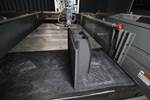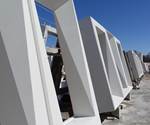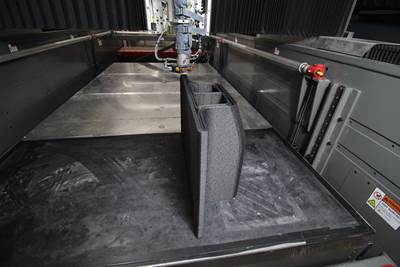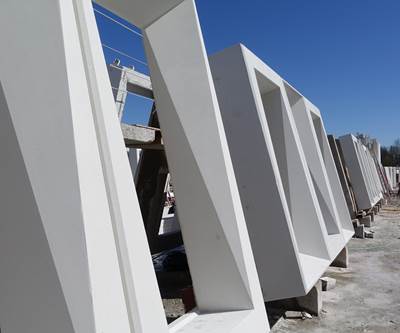Additive Engineering Solutions (AES) of Akron, Ohio, was one of the first commercial users of the Big Area Additive Manufacturing (BAAM) system, the large-scale polymer 3D printer developed by Oak Ridge National Lab (ORNL) in collaboration with Cincinnati Incorporated. Austin Schmidt and Andrew Bader first founded AES in 2016 as a provider of desktop 3D printing services, but pivoted into industrial tooling with the acquisition of a BAAM system. Bader’s family, the owners of metal stamping and fabricating company OGS Industries, provided financial and administrative backing for the venture, as well as the physical space for the business: a 14,000-square-foot industrial building that shares a parking lot with OGS.
When editor-in-chief Peter Zelinski first visited the facility in 2017, AES was awaiting the delivery of a five-axis router to serve its one BAAM system. When we both stopped by in 2019, there were three BAAM printers on the floor and two routers. By 2020 the count had grown to four BAAM printers and three CNC machines, and we began to hear how AES was expanding beyond its tooling mission, now producing end-use parts in addition to layup forms, concrete molds, stamping dies and other tooling.
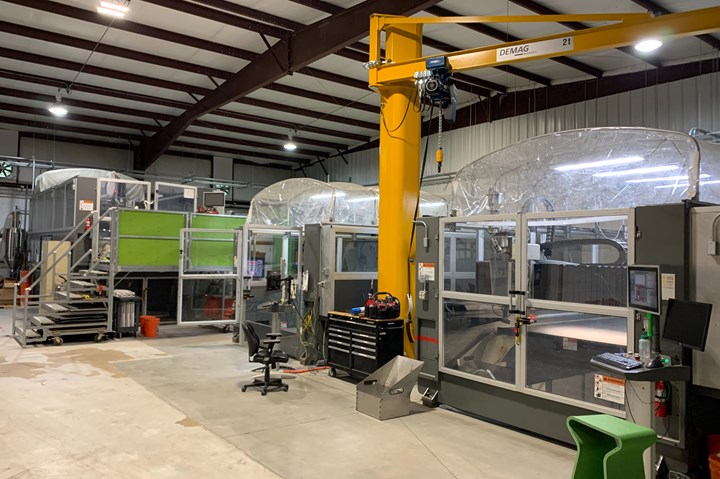
The current additive manufacturing capacity at AES. Its first Big Area Additive Manufacturing (BAAM) system is the elevated machine in the back, capable of 3D printing parts up to 6 feet tall. The two newer machines in the foreground are only designed to print up to 3 feet tall.
The expansion of the business has led its founders to consider another kind of expansion: vertical build height. In contrast to other extrusion systems where a printhead moves upwards as the build does, the BAAM systems keep the printhead on a gantry at the top of the build envelope and drop the platform instead. While the original BAAM system at AES offers a Z height of 6 feet, the newer two machines accommodate only half that.
Limited by the building’s ceiling height and unwilling to move the business, Schmidt and Bader found another solution: Print taller by going deeper. AES moved the two newer printers out of the way and commenced work on what the team affectionately calls “the Pit.” Essentially, they dug a hole and created a basement for these machines:
Completed in 2020, the Pit measures 27 by 18 feet, and is 6 feet deep. The two BAAM systems that sit over top of it can now print up to 8 feet tall. Finished builds can be raised up to floor level, making them easy to unload by hand or with a jib crane. I got a part’s-eye view of that journey on a recent visit. It takes about 10 minutes to ride the build platform all the way up from the bottom—see the video at the top of this post for a timelapse.
What is AES using this newfound capacity for? Although industrial tooling remains the largest share of its business, the company is increasingly taking on production work. One recent example involved 3D printing the five-part hull for an autonomous underwater vehicle (AUV) created by Dive Technologies. Learn more about this project on The Cool Parts Show.
Related Content
8 Cool Parts From Formnext 2024: The Cool Parts Show #78
End-use parts found at Formnext this year address various aspects of additive's advance, notably AM winning on cost against established processes.
Read MoreActivArmor Casts and Splints Are Shifting to Point-of-Care 3D Printing
ActivArmor offers individualized, 3D printed casts and splints for various diagnoses. The company is in the process of shifting to point-of-care printing and aims to promote positive healing outcomes and improved hygienics with customized support devices.
Read More3D Printing with Plastic Pellets – What You Need to Know
A few 3D printers today are capable of working directly with resin pellets for feedstock. That brings extreme flexibility in material options, but also requires greater knowledge of how to best process any given resin. Here’s how FGF machine maker JuggerBot 3D addresses both the printing technology and the process know-how.
Read MoreHow Norsk Titanium Is Scaling Up AM Production — and Employment — in New York State
New opportunities for part production via the company’s forging-like additive process are coming from the aerospace industry as well as a different sector, the semiconductor industry.
Read MoreRead Next
Ohio Business Sees Big Possibilities in BAAM for Tooling
A new startup built around a large-scale 3D printer aims to offer short lead times for large industrial tools.
Read More3D-Printed Tooling Offers Durability for Precast Concrete
As an alternative to wooden tooling, 3D-printed forms for precast concrete are proving to be more durable and better able to support a large-scale renovation project.
Read MoreAlquist 3D Looks Toward a Carbon-Sequestering Future with 3D Printed Infrastructure
The Colorado startup aims to reduce the carbon footprint of new buildings, homes and city infrastructure with robotic 3D printing and a specialized geopolymer material.
Read More

.jpg;width=70;height=70;mode=crop)
